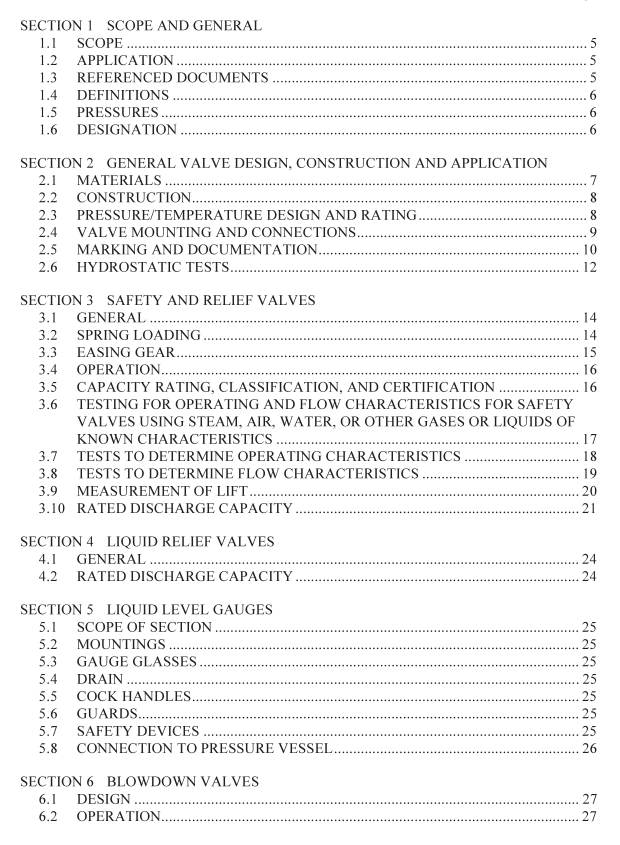AS 1271 pdf download – Safety valves, other valves, liquid level gauges and other fittings for boilers and unfired pressure vessels

AS 1271 pdf download – Safety valves, other valves, liquid level gauges and other fittings for boilers and unfired pressure vessels
2.1 MATERIALS
2.1.1 Material standards Material used in the construction of a valve or fitting shall comply with AS 1210. Alternative materials complying with the requirements of a relevant Specification of the British Standards Institution (BSI), or the American Society for Testing and Materials (ASTM), may be used. NOTE: The requirements of a Standard which relate to dimensional standardization only and not to performance and safety may be disregarded by agreement between the purchaser and the manufacturer.
2.1.2 Suitability Materials used in the construction of valves and fittings shall be suitable for the conditions of use, i.e. the material shall be— (a) suitable for the temperature and pressure of the fluid being handled under all operating conditions; (b) compatible with the fluid and with the material of adjacent components; and (c) suitable for the environment in which the valve is installed. Non-metallic materials shall not be used for pressure parts, with the exception of non-metallic seating components.
2.1.3 Limits of application A material shall not be used at a pressure or temperature outside the limits specified in the applicable Standards mentioned in Clause 2.1.1.
2.1.4 Castings and forgings Any casting or forging shall be smooth, sound, and free from cracks or other injurious defects. Variations of thickness at any place shall be gradual and substantial fillets shall be provided. NOTE: The specific quality standard for castings or forgings may be specified by the purchaser.
2.1.5 Repair of castings The requirements of the application Standard shall be met, however, any defect in a weldable alloy casting, except grey iron castings and spheroidal graphite iron castings, may be welded by an approved process, including any necessary subsequent heat treatment, provided that such repair does not impair the strength of the casting. Such defect shall be cleaned out to sound metal. The welding filler metal shall be such as will produce a weld having characteristics similar to the parent metal.
2.1.6 Impregnation of castings Castings that are found to be porous may be reclaimed by impregnation under the following conditions, provided that the porosity is not part of a linear defect:
(a) The application is one in which failure would not result in an immediate and significant hazard.
(b) The working temperature is not greater than 150°C. NOTE: In the event of the manufacturer supplying appropriate test certificates from an accredited test laboratory, this temperature may be increased to 210°C.
(c) The component is marked to show that it has been impregnated.
2.2 CONSTRUCTION
2.2.1 Bonnet and cover joint The bonnet or cover of a cast iron valve or fitting shall be of the bolted type. The bonnet or cover of a valve or fitting larger than DN 40 that is connected directly to a boiler or pressure vessel, or of any other valve or fitting larger than DN 60, shall be of the bolted, pressure-seal, screwed-and-welded, or welded type as appropriate for the operating conditions. Any screwed bonnet which includes the gland components shall incorporate positive means to prevent the inadvertent unscrewing of the bonnet, e.g. locked with grub screw, split pin, or similar device. Where the bonnet is used to retain a spring assembly of a safety or relief valve, it shall be arranged so that the disc is free of the seat before the bonnet can be removed.
2.2.2 Stems and stuffing boxes Additional to the requirements of the application Standard, any valve larger than DN 50, or any valve, irrespective of size, that will be subject to high temperatures or is intended to handle fluid that is likely to be corrosive, erosive, or to contain sediment or other material detrimental to stem screw threads, should be of the outside-screw type, i.e. one in which the actuating thread of the stem is exterior to the bonnet. No stuffing box shall have an internal thread. Gland nuts which could possibly be released by operation of a valve stem shall be designed and suitably locked to prevent inadvertent release. The design of the stem and gland arrangement should be such that leakage from an O-ring or other seals will occur before release of the stem. Positive means shall be provided to prevent the stem from being ejected on failure of any component.
2.2.3 Ball valve, plug cock, or cock The ported member shall be securely contained within the valve body by means other than the gland. The stem for rotating the ported member should be integral with it, or where this is not practicable, the connection should be sufficiently robust to obviate risk of shearing, and should be designed so that an incorrect angular relationship on reassembly is not possible. The stem shall be made from solid material, with the following exception. Lubrication channels may be drilled.









